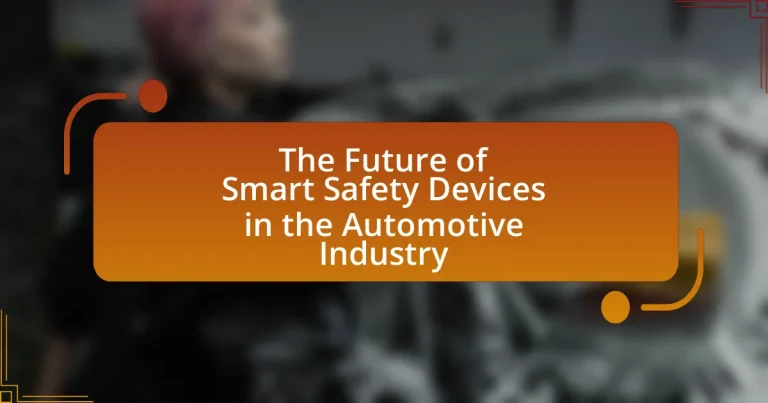Smart safety devices in the automotive industry represent advanced technologies aimed at enhancing vehicle safety and minimizing accident risks. These devices include features such as automatic emergency braking, lane departure warnings, and adaptive cruise control, which have been shown to significantly reduce crash rates. The article explores how these technologies integrate with vehicle systems, the driving forces behind their adoption, and the future trends shaping their development, including advancements in artificial intelligence and connectivity. Additionally, it addresses the challenges manufacturers face, such as cybersecurity concerns and regulatory compliance, while highlighting the opportunities for improved road safety and consumer trust.

What are Smart Safety Devices in the Automotive Industry?
Smart safety devices in the automotive industry are advanced technologies designed to enhance vehicle safety and reduce the risk of accidents. These devices include features such as automatic emergency braking, lane departure warning systems, adaptive cruise control, and collision avoidance systems. According to the National Highway Traffic Safety Administration, vehicles equipped with these technologies can significantly decrease crash rates, with studies showing a reduction in rear-end collisions by up to 40%. The integration of smart safety devices reflects the industry’s commitment to improving road safety through innovation and technology.
How do Smart Safety Devices enhance vehicle safety?
Smart safety devices enhance vehicle safety by utilizing advanced technologies such as sensors, cameras, and artificial intelligence to monitor driving conditions and assist drivers in real-time. These devices can detect potential hazards, provide alerts, and even intervene to prevent accidents. For instance, features like automatic emergency braking and lane-keeping assistance have been shown to reduce collision rates significantly, with studies indicating that vehicles equipped with these technologies can lower crash risks by up to 40%. Additionally, smart safety devices facilitate better communication between vehicles and infrastructure, further improving overall road safety.
What technologies are integrated into Smart Safety Devices?
Smart Safety Devices integrate technologies such as advanced sensors, artificial intelligence, machine learning, and connectivity features like V2X (Vehicle-to-Everything) communication. Advanced sensors, including cameras, radar, and LiDAR, enable real-time environment monitoring, while artificial intelligence and machine learning algorithms process data to enhance decision-making and predictive capabilities. V2X communication facilitates interaction between vehicles and infrastructure, improving safety and traffic management. These technologies collectively contribute to the development of autonomous driving systems and enhanced driver assistance features, significantly reducing accident rates and improving overall road safety.
How do these technologies interact with vehicle systems?
Smart safety devices interact with vehicle systems by integrating advanced sensors, communication protocols, and data processing capabilities to enhance safety features. These technologies, such as adaptive cruise control and lane-keeping assist, utilize real-time data from vehicle systems to monitor surroundings and make instantaneous adjustments to vehicle behavior. For instance, adaptive cruise control relies on radar and camera systems to maintain safe distances from other vehicles, automatically adjusting speed based on traffic conditions. This interaction not only improves driver safety but also contributes to overall traffic efficiency, as evidenced by studies showing a reduction in collision rates when such systems are employed.
Why is the automotive industry focusing on Smart Safety Devices?
The automotive industry is focusing on Smart Safety Devices to enhance vehicle safety and reduce accidents. These devices utilize advanced technologies such as sensors, cameras, and artificial intelligence to monitor driving conditions and provide real-time feedback to drivers. For instance, according to the National Highway Traffic Safety Administration, advanced driver-assistance systems (ADAS) can potentially reduce traffic fatalities by up to 30%. This emphasis on smart safety aligns with the industry’s goal of achieving higher safety standards and meeting regulatory requirements, as well as responding to consumer demand for safer vehicles.
What are the key trends driving the adoption of Smart Safety Devices?
Key trends driving the adoption of Smart Safety Devices include advancements in technology, increasing consumer demand for safety features, and regulatory pressures for enhanced vehicle safety. Technological innovations, such as artificial intelligence and machine learning, enable real-time data processing and predictive analytics, improving safety outcomes. Consumer preferences are shifting towards vehicles equipped with advanced safety features, as evidenced by a 2022 survey indicating that 70% of buyers prioritize safety technology in their purchasing decisions. Additionally, governments worldwide are implementing stricter safety regulations, such as the European Union’s General Safety Regulation, which mandates the inclusion of certain safety technologies in new vehicles, further accelerating the adoption of Smart Safety Devices.
How do consumer expectations influence the development of these devices?
Consumer expectations significantly influence the development of smart safety devices in the automotive industry by driving manufacturers to prioritize features that enhance user experience and safety. As consumers increasingly demand advanced technologies, such as automated driving systems and real-time safety alerts, manufacturers respond by integrating these innovations into their products. For instance, a survey by McKinsey & Company found that 70% of consumers are willing to pay more for vehicles equipped with advanced safety features, indicating a clear market trend that shapes product development strategies. This alignment between consumer expectations and technological advancements ensures that automotive companies remain competitive and relevant in a rapidly evolving market.

What are the Future Trends for Smart Safety Devices?
Future trends for smart safety devices in the automotive industry include the integration of advanced driver-assistance systems (ADAS), increased use of artificial intelligence (AI) for predictive analytics, and the development of vehicle-to-everything (V2X) communication technologies. ADAS features, such as automatic emergency braking and lane-keeping assistance, are becoming standard in new vehicles, enhancing overall safety. AI is being utilized to analyze driver behavior and environmental conditions, allowing for real-time adjustments to safety protocols. V2X communication enables vehicles to interact with each other and infrastructure, improving situational awareness and reducing the likelihood of accidents. According to a report by MarketsandMarkets, the global ADAS market is projected to grow from $27.5 billion in 2020 to $83.4 billion by 2025, highlighting the increasing emphasis on smart safety technologies in the automotive sector.
How will advancements in technology shape Smart Safety Devices?
Advancements in technology will significantly enhance Smart Safety Devices by integrating artificial intelligence, machine learning, and advanced sensor technologies. These innovations will enable real-time data processing and predictive analytics, allowing vehicles to anticipate and respond to potential hazards more effectively. For instance, AI algorithms can analyze driving patterns and environmental conditions to improve collision avoidance systems, as evidenced by the increasing adoption of features like automatic emergency braking in modern vehicles. Additionally, advancements in connectivity, such as 5G networks, will facilitate seamless communication between vehicles and infrastructure, further enhancing the functionality and reliability of Smart Safety Devices.
What role will artificial intelligence play in future Smart Safety Devices?
Artificial intelligence will play a crucial role in enhancing the functionality and effectiveness of future Smart Safety Devices in the automotive industry. AI will enable these devices to analyze real-time data from various sensors, improving decision-making processes for accident prevention and driver assistance. For instance, AI algorithms can process information from cameras and radar systems to detect obstacles, predict potential collisions, and provide timely alerts to drivers, significantly reducing accident rates. According to a study by the National Highway Traffic Safety Administration, advanced driver-assistance systems that utilize AI have the potential to prevent up to 40% of crashes, demonstrating the transformative impact of AI on automotive safety.
How will connectivity and IoT impact Smart Safety Devices?
Connectivity and IoT will significantly enhance Smart Safety Devices by enabling real-time data exchange and improved responsiveness. This integration allows devices to communicate with each other and with centralized systems, facilitating immediate alerts and actions in emergency situations. For instance, connected vehicles can share information about road conditions, potential hazards, and driver behavior, which can lead to proactive safety measures. According to a report by McKinsey & Company, the adoption of IoT in automotive safety systems could reduce accident rates by up to 30% by providing timely information and automated responses. This demonstrates that the impact of connectivity and IoT on Smart Safety Devices is profound, leading to safer driving experiences and reduced risks on the road.
What regulatory changes are expected to affect Smart Safety Devices?
Regulatory changes expected to affect Smart Safety Devices include the implementation of stricter safety standards and data privacy regulations. The National Highway Traffic Safety Administration (NHTSA) is anticipated to introduce new guidelines that mandate enhanced testing and validation processes for smart safety features in vehicles, ensuring they meet higher safety benchmarks. Additionally, the General Data Protection Regulation (GDPR) and similar data protection laws are likely to influence how manufacturers collect, store, and utilize user data from these devices, necessitating greater transparency and user consent. These changes aim to improve overall vehicle safety and protect consumer privacy, reflecting a growing emphasis on accountability in the automotive industry.
How will safety standards evolve in relation to Smart Safety Devices?
Safety standards will evolve to incorporate advanced technologies and data analytics in Smart Safety Devices. As these devices become more integrated into vehicles, regulatory bodies will likely establish new guidelines that address their unique functionalities, such as real-time monitoring and automated responses to hazards. For instance, the National Highway Traffic Safety Administration (NHTSA) has already begun to adapt its framework to include standards for vehicle-to-vehicle communication and automated driving systems, reflecting the growing reliance on smart technology in enhancing safety. This evolution will ensure that safety standards not only keep pace with technological advancements but also prioritize user safety and data security.
What implications do these regulations have for manufacturers?
These regulations impose stricter compliance requirements on manufacturers, necessitating significant investments in technology and processes to meet safety standards. Manufacturers must adapt their production lines to integrate advanced safety features, which may increase operational costs and extend development timelines. For instance, the implementation of regulations such as the European Union’s General Safety Regulation mandates that new vehicles include advanced driver-assistance systems, compelling manufacturers to innovate rapidly and ensure their products are compliant before market entry. This shift not only affects financial planning but also influences competitive dynamics within the automotive industry, as manufacturers that can efficiently adapt to these regulations may gain a market advantage.

What Challenges and Opportunities Exist for Smart Safety Devices?
Smart safety devices in the automotive industry face challenges such as cybersecurity threats and integration complexities, while also presenting opportunities for enhanced vehicle safety and data-driven insights. Cybersecurity risks arise from the connectivity of these devices, making them vulnerable to hacking, as evidenced by the 2020 report from the National Highway Traffic Safety Administration, which highlighted increased incidents of vehicle hacking. Integration complexities stem from the need to harmonize various technologies and standards across manufacturers, which can delay deployment. Conversely, the opportunity for improved safety is significant; for instance, advanced driver-assistance systems (ADAS) have been shown to reduce accidents by up to 40%, according to a study by the Insurance Institute for Highway Safety. Additionally, the ability to collect and analyze data from smart safety devices can lead to better decision-making and proactive safety measures, further enhancing the overall safety of vehicles on the road.
What are the main challenges facing the implementation of Smart Safety Devices?
The main challenges facing the implementation of Smart Safety Devices include high costs, technological integration, regulatory compliance, and user acceptance. High costs can deter manufacturers from adopting advanced safety technologies, as initial investments may not yield immediate returns. Technological integration poses difficulties due to the need for compatibility with existing vehicle systems and infrastructure. Regulatory compliance is essential, as manufacturers must navigate complex safety standards and testing requirements, which can vary by region. Lastly, user acceptance is critical; consumers may resist adopting new technologies due to concerns about reliability or usability. These challenges collectively hinder the widespread adoption of Smart Safety Devices in the automotive industry.
How do cybersecurity concerns affect Smart Safety Devices?
Cybersecurity concerns significantly impact Smart Safety Devices by increasing the risk of unauthorized access and manipulation of these systems. As Smart Safety Devices in vehicles rely on interconnected networks and data exchange, vulnerabilities can lead to potential breaches that compromise safety features, such as automatic braking or collision avoidance systems. For instance, a study by the National Highway Traffic Safety Administration (NHTSA) highlighted that 80% of vehicle crashes could be mitigated by advanced safety technologies, but cybersecurity threats can undermine their effectiveness. Therefore, addressing cybersecurity is crucial to ensure the reliability and safety of Smart Safety Devices in the automotive industry.
What are the cost implications for manufacturers and consumers?
The cost implications for manufacturers and consumers of smart safety devices in the automotive industry include increased production costs for manufacturers and potential savings for consumers through reduced accident-related expenses. Manufacturers face higher initial investments in technology development, materials, and compliance with safety regulations, which can lead to increased vehicle prices. For instance, the integration of advanced driver-assistance systems (ADAS) can add approximately $1,000 to $3,000 to the cost of a vehicle. Conversely, consumers may benefit from lower insurance premiums and reduced medical costs due to fewer accidents, as studies indicate that vehicles equipped with smart safety features can reduce crash rates by up to 40%. This dual impact highlights the financial dynamics at play in the adoption of smart safety technologies.
What opportunities can arise from the integration of Smart Safety Devices?
The integration of Smart Safety Devices in the automotive industry presents opportunities such as enhanced vehicle safety, improved accident prevention, and increased consumer trust. These devices utilize advanced technologies like sensors and artificial intelligence to monitor driving conditions and driver behavior, significantly reducing the likelihood of accidents. For instance, a study by the National Highway Traffic Safety Administration found that vehicles equipped with advanced driver-assistance systems can reduce crash rates by up to 40%. Additionally, the data collected from these devices can inform manufacturers about safety trends, leading to better design and engineering of future vehicles. This integration not only fosters innovation but also creates a competitive advantage for manufacturers who prioritize safety, ultimately benefiting consumers and the industry as a whole.
How can Smart Safety Devices improve overall road safety statistics?
Smart safety devices can significantly improve overall road safety statistics by reducing the frequency and severity of accidents through advanced technologies such as collision avoidance systems, adaptive cruise control, and real-time monitoring of driver behavior. These devices utilize sensors and algorithms to detect potential hazards, alert drivers, and even take corrective actions, thereby preventing accidents before they occur. For instance, studies have shown that vehicles equipped with automatic emergency braking systems can reduce rear-end collisions by up to 40%. Additionally, the integration of smart safety devices with traffic management systems can optimize traffic flow, further decreasing the likelihood of accidents.
What potential markets are emerging for Smart Safety Devices?
Emerging markets for Smart Safety Devices include the automotive, healthcare, and home automation sectors. In the automotive industry, the demand for advanced driver-assistance systems (ADAS) is growing, driven by increasing safety regulations and consumer preferences for enhanced vehicle safety features. According to a report by MarketsandMarkets, the global ADAS market is projected to reach $83 billion by 2025, highlighting significant investment in smart safety technologies. In healthcare, smart safety devices are being integrated into patient monitoring systems, with a projected market growth from $5 billion in 2020 to $12 billion by 2025, as reported by Grand View Research. Additionally, the home automation market is expanding, with smart safety devices like security cameras and smoke detectors expected to grow significantly, driven by consumer demand for smart home solutions.
What best practices should manufacturers follow when developing Smart Safety Devices?
Manufacturers developing Smart Safety Devices should prioritize user-centered design, ensuring that devices are intuitive and accessible for all users. This approach enhances usability and increases the likelihood of adoption, as evidenced by studies showing that user-friendly interfaces lead to higher satisfaction rates. Additionally, manufacturers must implement rigorous testing protocols to validate the reliability and effectiveness of safety features under various conditions, as demonstrated by the National Highway Traffic Safety Administration’s guidelines, which emphasize the importance of real-world testing scenarios. Furthermore, integrating advanced data analytics can help manufacturers continuously improve device performance by analyzing user behavior and incident data, leading to proactive safety enhancements. Lastly, compliance with industry standards and regulations is crucial, as adherence ensures that devices meet safety benchmarks and fosters consumer trust.


